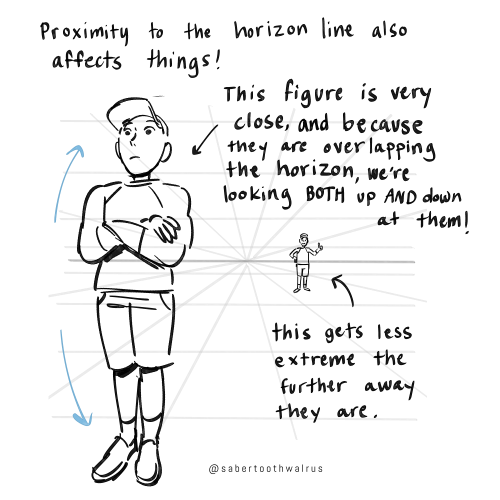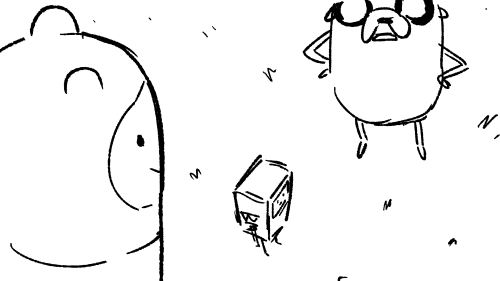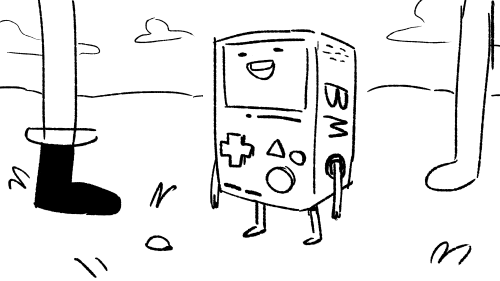Stubbytime - IT IS OKAY.
More Posts from Stubbytime and Others
Someone has probably already asked you this but do you have any tips on studying/understanding perspective? I keep trying to find resources to learn but none of them really stick or are actually useful
so I'm hoping that your issue isn't just figuring out the difference between 1-point, 2-point, and 3-point perspective and how it works, because there are tons and tons of resources available for that, and I'm guessing what people tend to get tripped up on is what you're supposed to be doing with your grid.
I'm definitely far from being an expert on understanding perspective, but I'll share some of the things that helped ME finally Get It.



Things like eye level and different camera angles can be a GREAT tool to use when doing a comic or storyboard between multiple characters of different heights!! I actually drew an example of this exact thing for a friend about a month ago (I used adventure time characters bc they're easy to draw and have a good height variety):






You can use camera angles like this to add variety to your shots, and even use it to help convey something emotional (using a down-shot on a character to show that they FEEL small, use an up-shot on a character to make them look more intimidating, etc etc)
hope this helps!
people already sent me this over 15 times
i feel completely and totally normal about this. nothing irrational happening in my brain.
mental health tips i wish i’d been given before starting university
trying is much more important than succeeding
10 minutes of studying > not studying at all
being a college student is more than academics. it’s also learning how to enjoy your own company, learning and occasionally screwing up meals, wandering outside campus like a tourist, questioning your ideals and presuppositions, discovering new talents and skills for the hell of it, and SO much more. if you feel burnt out in one dimension of college life, that’s a sign to spend some time relishing in another dimension.
if you need more time, take a deep breath and shoot that email to your professor/TA asking for an extension. at worst, they say no. and don’t stress over properly explaining yourself/your situation. hell, just email them: “Hi, Professor. I need your help. Sincerely, y/n.” all it takes is that one initial reach out and the rest will follow.
failure does not reflect character. read that again. remind yourself as often as you see fit because at one point or another, you will feel like you’ve failed. it’s growing pains. once you’ve accepted that, learn to view any setbacks as a hint that you need to try a new method/approach. didn’t do well on that math quiz? don’t beat yourself up over it–instead, regroup with yourself and see which metaphorical gear got stuck in your personal learning process machine. for instance, maybe you used flash cards and that wasn’t really your style. act like a detective, not a bully.
THERE IS NO NORMAL TIMELINE FOR YOUR COLLEGE CAREER(!!!!!!). a lot of people need more than 4 years, a lot of people need 4 years, and a lot of people need less than 4 years. and every single one of those timelines are valid. the worst thing you could do is squeeze the living hell out of yourself into some rigid schedule that is incompatible with who you are and how you learn. trust me when i say u will find yourself doing the best work when u do it at YOUR pace.
Plant Care 101: The Basics
It’s kind of hard to give a super basic guide to plant care because plants are super diverse and have varying care requirements BUT there are some things that every plant needs and that you can apply pretty broadly to caring for plants. This is going to be focused on container plants and houseplants more than plants in the ground/garden because that’s a whole other can of worms, but yeah, anyway, here’s some quick tips for beginner plant ownership.
1. LIGHTING - Think about where you’re actually going to put your plants
… before you get them (ideally). All plants need light. No plant will live in a windowless bathroom or basement (I mean unless you have grow lights BUT that’s another story). Very few plants will survive in a dark, dim corner.
Figure out which direction your house faces! Different plants do best in different light exposures. Afternoon sun (west) is hotter than morning sun (east) and can dehydrate plants faster or cause sunburn. Southern exposures get the most direct sun, and northern exposures get mostly indirect sun or no sun. And obstacles like trees or awnings will potentially block light as well.
Full sun is considered 6+ hours of direct sun, part sun is 2-4 hours of direct sun, and shade is less than two hours of direct sun. Keep in mind the sun intensity will vary depending on your location and the time of year.
A lot of houseplants prefer “bright, indirect light”. In a window that gets hot, direct sunlight like a south or west window, this could mean putting up a sheer curtain or keeping the plants farther away from the window. East windows generally get bright indirect light all year and north windows may not be bright enough for most except the lowest light plants.
Get plants to suit your space! Do some research! If you have trouble identifying the plants that you already have, try google image searching using various details about it. Sometimes that works.
2. POTS AND SOIL - Think about your plant’s house
Your plant’s house is its pot. When you bring it home from the store or nursery, it’s a good idea to replant it. The soil that’s best for keeping the plant alive in the store is usually different than the soil that’s best for it in your house. Especially if you’re getting your plants from stores like Home Depot, Lowes, Wal-mart, etc (it’s gross). Taking a look at a plant’s roots is important! A lot can hide under the surface of the soil…
I can’t really recommend a specific soil brand because everything varies regionally and every plant is going to have different soil needs, so really this is just trial and error. Try out different soils! Experiment with perlite which will make your soil looser and drain better. For succulents, I use a mix of topsoil (not potting soil), sand, and perlite.
You generally want your generic potting soil to A) absorb some moisture but B) drain well. Which may seem contradictory, but it isn’t, I promise.
As for your pot….. DRAINAGE HOLES ARE A MUST. If your pot doesn’t drain, you can put your plant in a plastic insert and remove that to water it, you can attempt to add your own drainage holes, or you can doom your plant to slow and inevitable death. If your pot does have drainage holes, test it first to see if it actually drains.
Increase the size of your plant’s pot only a few inches at a time. Tiny plants in giant pots aren’t ideal, mainly because the soil dries down inconsistently. The soil around the edges may be dry but soil at the roots may still be wet. Also, don’t plant your plants too low! The soil should stop about an inch or so below the top of the pot. Planting too low can cause issues with air circulation to the stem/soil which can cause rot issues. (tbh I’ll probably make a specific post about repotting plants because there are a lot of things to know and a lot of tips and tricks)
As for the type of pot, that’s up to you. Plain terracotta pots are helpful for plants that like to dry down between waterings because they wick moisture from the soil… not as ideal for plants that love lots of water. Also, there’s no shame in plain, plastic pots. None.
3. WATERING - please don’t drown your thirsty boys
This one’s the hardest to do an overview of because different plants and even the same plants in different locations have vastly different watering needs.
Plants (usually) only take up water when the photosynthesize. Less light = less photosynthesizing = less water taken up. Cloudy day? Less water taken up. In the greenhouse, we generally don’t water on cloudy days because the plants don’t take up as much water and because water sitting on the leaves/soil doesn’t evaporate as quickly potentially leading to rot issues.
You can usually visually tell if the soil is dry. To be more sure that the soil is really dry, poke your finger in about an inch. To be more, more sure, you can wiggle a wooden chopstick in the soil and if it comes out dry, the soil is dry. Some plants prefer to dry down almost completely before watering again, some prefer about 30-50%, some like to stay moist but not drowning.
If your plant appears to be wilting, check the soil. If it’s wet, it may be overwatered or sick. Don’t water for a bit and check the stem/roots for rot. If it’s dry, it’s likely underwatered. Very dry soil can take a few repeat waterings to actually absorb moisture again.
It is better to water deeply infrequently than to water in small amounts more frequently. Your goal when watering is to dump in enough water that it flows vigorously out of the drainage holes. When I first started watering plants I thought it was way too much but seriously, dump that water in there. No trickles allowed.
4. PLANT ISSUES - wtf is wrong with my plant
You’re going to run into plant issues when keeping plants, that’s just how it is. Diseases, bugs, rot, etc.
There are WAY too many issues to get into in a basic post like this, but in general…. pay attention to your plant! Look at the undersides of the leaves and leaf tips and the stem. Take lots of pictures! Touch your plant and the soil! Keep an eye out for changes.
If your plant does develop what you think is an issue, google is your friend. I’ve googled so much of the stuff I know about plants, even when I’m working with very experienced growers. Google is good. Don’t rely solely on one source of info.
And if your plant unfortunately kicks the bucket? No, you don’t have a black thumb. There is no such thing. That’s especially a time to google the shit out of that plant and re-evaluate your growing conditions. I’ve killed LOADS of plants and that was usually because I put a plant in a less than ideal location and then didn’t give it the right care. Or because of bad luck.
There is NO SUCH THING as a black thumb.
I think that’s about it really for the basics. There’s also stuff like pH and humidity and temperature, etc etc to consider but that’s way too much to get into in just one post. Hopefully this makes some kind of sense and isn’t just a wall of text? And is helpful? If you have any other questions, feel free to message me if you’d like. Or add onto this post with other tips if you have them.


its been a long day pass the yuri
The only way I feel I can adequately describe my feelings on the chewis dynamic is that I think Charles would call Lewis mommy.



Part 2 of cino art tips is some basic tips on shape and silhouette design which are also principles I think about a lot :)
(also i'm so sorry i chose comic sans to write this in idk what i was thinking but i already flattened the layers)
i don't have any other obvious tips off the top of my head rn but feel free to ask anything you are curious about! i love getting asks uwu
So uh….some dude apparently recreated Adobe Photoshop feature-for-feature, for FREE, and it runs in your browser.
Anyway, fuck Adobe, and enjoy!








i’m luke skywalker. i’m here to rescue you. dust bowl dance, mumford & sons
-
 rocioandthatsall reblogged this · 1 month ago
rocioandthatsall reblogged this · 1 month ago -
 nathandaws liked this · 1 month ago
nathandaws liked this · 1 month ago -
 datto-el-gato liked this · 1 month ago
datto-el-gato liked this · 1 month ago -
 euuzaik reblogged this · 1 month ago
euuzaik reblogged this · 1 month ago -
 wishvolo reblogged this · 1 month ago
wishvolo reblogged this · 1 month ago -
 wishvolo liked this · 1 month ago
wishvolo liked this · 1 month ago -
 raekeiko reblogged this · 1 month ago
raekeiko reblogged this · 1 month ago -
 a-syzygy-dreamt reblogged this · 1 month ago
a-syzygy-dreamt reblogged this · 1 month ago -
 a-syzygy-dreamt liked this · 1 month ago
a-syzygy-dreamt liked this · 1 month ago -
 cellowerk reblogged this · 1 month ago
cellowerk reblogged this · 1 month ago -
 cellowerk liked this · 1 month ago
cellowerk liked this · 1 month ago -
 k1ttyqueen reblogged this · 1 month ago
k1ttyqueen reblogged this · 1 month ago -
 bugs-r-neat liked this · 1 month ago
bugs-r-neat liked this · 1 month ago -
 the-motan reblogged this · 1 month ago
the-motan reblogged this · 1 month ago -
 azurehaiku reblogged this · 1 month ago
azurehaiku reblogged this · 1 month ago -
 thisistomuchforme reblogged this · 1 month ago
thisistomuchforme reblogged this · 1 month ago -
 valdotpng liked this · 1 month ago
valdotpng liked this · 1 month ago -
 mug-of-shark reblogged this · 1 month ago
mug-of-shark reblogged this · 1 month ago -
 spids reblogged this · 1 month ago
spids reblogged this · 1 month ago -
 spids liked this · 1 month ago
spids liked this · 1 month ago -
 certifieditsbo liked this · 1 month ago
certifieditsbo liked this · 1 month ago -
 roadkilledjackal liked this · 1 month ago
roadkilledjackal liked this · 1 month ago -
 fairiesdobesparklin reblogged this · 1 month ago
fairiesdobesparklin reblogged this · 1 month ago -
 fairiesdobesparklin liked this · 1 month ago
fairiesdobesparklin liked this · 1 month ago -
 valentines-gay liked this · 1 month ago
valentines-gay liked this · 1 month ago -
 stitched--skins reblogged this · 1 month ago
stitched--skins reblogged this · 1 month ago -
 miscellaneous--bones liked this · 1 month ago
miscellaneous--bones liked this · 1 month ago -
 angel-of-fallen-dreams reblogged this · 1 month ago
angel-of-fallen-dreams reblogged this · 1 month ago -
 angel-of-fallen-dreams liked this · 1 month ago
angel-of-fallen-dreams liked this · 1 month ago -
 solar-galaxy-gardener liked this · 1 month ago
solar-galaxy-gardener liked this · 1 month ago -
 light-of-knowledge reblogged this · 1 month ago
light-of-knowledge reblogged this · 1 month ago -
 light-of-knowledge liked this · 1 month ago
light-of-knowledge liked this · 1 month ago -
 shrimplovercat reblogged this · 1 month ago
shrimplovercat reblogged this · 1 month ago -
 happyallykats reblogged this · 1 month ago
happyallykats reblogged this · 1 month ago -
 sucker-for--anything-acoustic liked this · 1 month ago
sucker-for--anything-acoustic liked this · 1 month ago -
 lemonlimekodkod liked this · 1 month ago
lemonlimekodkod liked this · 1 month ago -
 thegnomedruid reblogged this · 1 month ago
thegnomedruid reblogged this · 1 month ago -
 wookieeoftheyear liked this · 1 month ago
wookieeoftheyear liked this · 1 month ago -
 dragonbornoflegend reblogged this · 1 month ago
dragonbornoflegend reblogged this · 1 month ago -
 chronically-done reblogged this · 1 month ago
chronically-done reblogged this · 1 month ago -
 sugarcandybullet liked this · 1 month ago
sugarcandybullet liked this · 1 month ago -
 ghostsaberwolf reblogged this · 1 month ago
ghostsaberwolf reblogged this · 1 month ago -
 shadynewjersey liked this · 1 month ago
shadynewjersey liked this · 1 month ago -
 christchex reblogged this · 1 month ago
christchex reblogged this · 1 month ago -
 christchex liked this · 1 month ago
christchex liked this · 1 month ago -
 akumastrife reblogged this · 1 month ago
akumastrife reblogged this · 1 month ago -
 tigerking-of-kings reblogged this · 1 month ago
tigerking-of-kings reblogged this · 1 month ago -
 strawberrymilk4k liked this · 1 month ago
strawberrymilk4k liked this · 1 month ago -
 peach-frogge reblogged this · 1 month ago
peach-frogge reblogged this · 1 month ago -
 educationalporpoises reblogged this · 1 month ago
educationalporpoises reblogged this · 1 month ago
